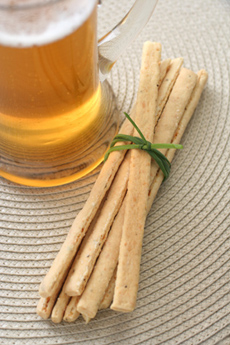

A satisfying snack: Parmesan breadsticks and a craft beer. Photo by Michael Steele | THE NIBBLE.
July 2010
|
 |
Breadstick History
Invented In Italy, But Can You Believe The Story?
Grissini: The Original Breadsticks
According to the history of the bread stick provided by EKO, an Italian manufacturer of organic bread sticks, the original Italian bread sticks, grissini, originated in the Piedmont region of Italy (Piemonte in Italian, the extreme northeast sector of Italy, highlighted on the map at the left). There are two stories: one based on oral tradition, the other on old written records. Romantic or a logician, take your choice:
According to oral tradition, it was the year 1675, and the young duke of the House of Savoy, Vittorio Amedeo II di Savoia, was nine years old. Frail since birth, especially suffering from intestinal disorders that affected his ability to eat and thus his physical development, he was seriously ill again. His mother asked the court physician to find a remedy to feed her son.
The physician had a great insight and was able to diagnose food poisoning from bread polluted by pathogenic intestine germs. According to the story, as a youth the physician himself had suffered from similar intestine disorders, which had been remedied by his mother’s bread, “well leavened, well baked with little crumb and very crisp.” The physician had the Savoia’s baker reproduce the bread sticks; the duke recovered, his build improved and he became the first Piedmont king, in 1713.
The crisp grissino became the preferred bread in the Savoia household, and thus became known and appreciated by all visiting royalty and aristocrats of the time.
It’s a nice story. However, historical records indicate that in 1679, just four years after Duke Vittorio ate his first bread stick, heavy demand for the product made it necessary for officials to set a ceiling price.
|
|

Sickly young Duke Vittorio is said to have been cured by breadsticks. He grew up to be King of Sicily in 1713 and King of Sardinia. Image courtesy Wikimedia. |
It seems likely, therefore, that grissini had been enjoyed by the public for much longer than four years, and that one has to search for an origin further back in time.
In another historic record, in 1643, 32 years earlier, a Florentine abbot found a novelty bread “with a bizarre shape, that is a bread loaf an arm long and thin like dead bones” in a town outside of Turin. Going back further in time, a reference can be found to a special type of bread called pane barotellatus—in the dialect of Piedmont, barot means stick. (For more historic detail, visit the EKO website.)
As with most of our foods, the exact origin will likely never be known—but we can take crunchy comfort in the legacy.

|





